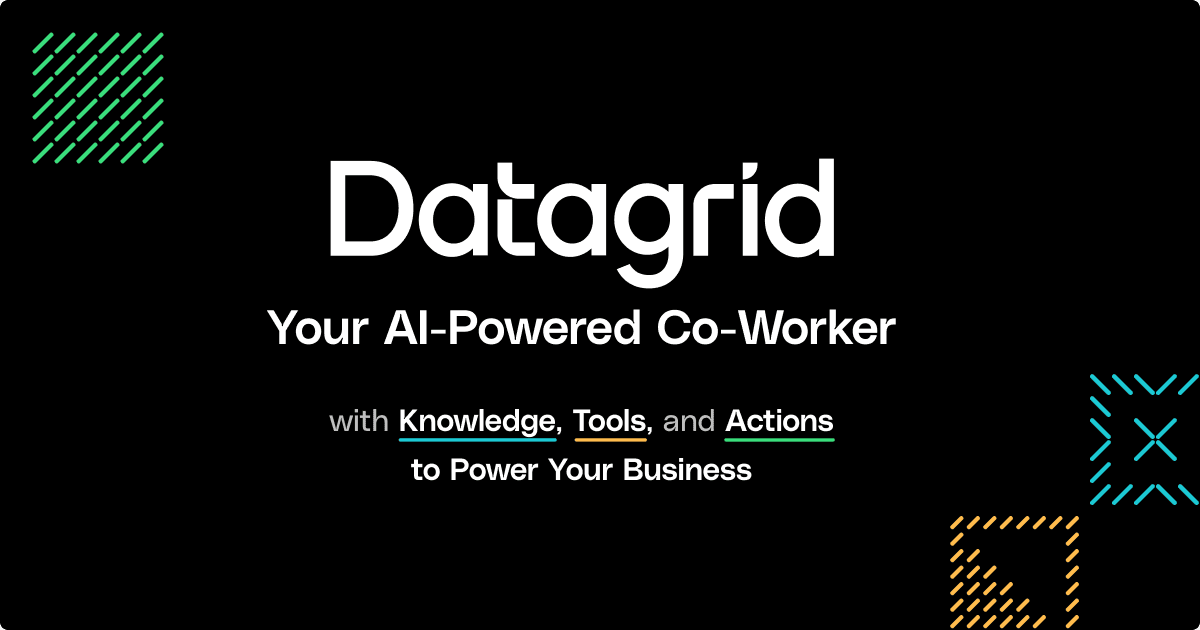All Posts
Productivity tools and techniques
How to Seamlessly Automate Finance Data Management with AI-Powered Solutions

Discover the power of AI in financial data management. Learn how automation reduces errors, saves time, and offers real-time insights for strategic decisions.
Are you wondering how to automate finance data management to save time and reduce errors? If you're drowning in manual processes and wasting countless hours on tasks that could be automated, you're not alone. The pain of reconciling data across departmental silos, correcting costly mistakes, and struggling with outdated reporting isn't just inefficient—it's holding your business back from its potential.
AI-driven solutions like Agentic AI are transforming this landscape, making finance data automation more accessible than ever. This article explores how AI solutions like Datagrid's data connectors can help you automate finance data management, eliminating critical pain points and transforming your financial operations by automating tedious processes and seamlessly connecting your disparate systems.
The Business Case for Automating Finance Data Management
Financial organizations worldwide recognize that manual finance data management processes simply don't work in today's complex business environment. Building a strong case for finance automation means understanding both the challenges of manual processes and the measurable benefits automation delivers.
Key Challenges
Manual finance data management creates significant operational burdens that directly hit an organization's bottom line:
Operational Inefficiency and Cost Implications
Manual processes, including tasks that could benefit from automating order forms review, devour time and resources. This inefficiency translates to higher costs and reduced productivity as skilled finance professionals waste hours on repetitive tasks instead of strategic work.
Increased Risk of Human Error
The financial consequences of manual errors can be devastating. Even small data entry mistakes can cascade into major financial reporting problems, undermining trust and compliance. Manual systems create disconnected information repositories across departments. These silos prevent a unified business view, making reconciliation time-consuming and hindering comprehensive financial analysis.
Compliance Risks
Regulatory requirements grow more complex daily, and manual processes struggle to keep pace. Poor data quality and delayed reporting directly increase regulatory risk exposure. Paper records and unsecured spreadsheets create serious security risks for sensitive financial data.
Lack of Real-Time Insights
Manual processes delay financial reporting and analysis. This lag creates a strategic disadvantage, as seen with multinational companies struggling to pivot during market downturns because their financial reports were outdated by the time leadership received them.
Essential Components When Automating Finance Data Management
Finance data automation is changing how organizations manage their financial operations by eliminating manual processes, reducing errors, and enabling real-time insights. To build an effective automation system, you need three core components working together to create a seamless data management ecosystem.
Data Extraction and Collection
The foundation of any finance data automation system is its ability to gather information from various sources without manual intervention:
Optical Character Recognition (OCR): Converts printed or handwritten text from documents like invoices, receipts, and contracts into machine-readable data. Modern OCR systems recognize diverse layouts, fonts, and even handwritten text with impressive accuracy, enabling PDF parsing automation for financial documents.
Intelligent Document Processing (IDP): Combines OCR with AI to understand document context and extract specific information through automated document parsing. An IDP system can identify and extract invoice numbers, line items, and payment terms from various invoice formats automatically.
API Integrations: Direct connections between your financial systems and external platforms enable automatic data flow, eliminating manual downloads and uploads while ensuring real-time data availability.
By implementing these extraction technologies, you can redirect this time toward more strategic activities.
Data Processing and Transformation
Once data is extracted, it needs processing and data transformation into useful information. This middle layer turns raw data into valuable financial intelligence:
Data Normalization: Standardizes information from different sources into consistent formats. For example, dates might appear as MM/DD/YYYY in one system and DD-MM-YYYY in another. Normalization ensures all dates follow the same convention throughout your financial data.
Rules-Based Classification: Applies predefined rules to categorize transactions. Purchases from specific vendors can be automatically assigned to the correct expense categories, saving hours of manual classification work.
Validation Frameworks: Automatically check data against business rules and flag exceptions. Validation might identify duplicate invoices or payments exceeding authorized limits, preventing potential errors or fraud.
Data Enrichment: AI-powered platforms automatically enhance financial data with additional context. This might include adding market data to securities, appending risk scores to transactions, or linking related entries across different systems.
Analysis and Reporting Automation
With clean, processed data, businesses can leverage powerful analysis and reporting automation, including AI automation, which can significantly improve efficiency:
Automated Reconciliation: Systems match transactions across multiple sources to identify discrepancies without manual intervention, dramatically reducing time needed for period-end closing.
Dynamic Dashboards: Real-time visualization tools present financial data in interactive formats, letting you drill down into specific metrics or transactions. Unlike static reports, these dashboards update automatically as new data enters the system.
Predictive Analytics: Advanced AI algorithms, including AI agents, identify patterns in historical financial data to forecast future trends, helping with cash flow planning, budget forecasting, and early risk detection.
Natural Language Processing (NLP): Enables systems to generate narrative explanations of financial data or allows users to query financial information using natural language questions rather than complex formulas.
By integrating these three components—extraction, processing, and analysis—into your finance operations, you'll create a comprehensive automation system that saves time, reduces errors, and provides deeper insights for strategic decision-making.
Implementation Framework for Automating Finance Data Management
Implementing finance automation requires a structured approach to ensure success. Following a clear framework helps maximize benefits while minimizing potential pitfalls.
Assessment and Planning Phase
Begin your automation journey with a thorough assessment of your current finance processes. Document all existing financial processes in detail. Identify inputs, outputs, dependencies, and stakeholders for each process. Evaluate each process based on:
- Volume of transactions
- Frequency of execution
- Error rates
- Time consumption
- Strategic importance
Prioritize processes where automation would deliver the highest return. Map how financial data moves through your organization. Identify bottlenecks, manual handoffs, and redundancies creating inefficiencies. Compare your current state with industry best practices to identify specific improvement opportunities.
Technology Selection Criteria
Once you've completed your assessment, you'll need clear criteria for selecting the right technology solutions. Evaluate how potential solutions will connect with existing systems. Focus on:
- API capabilities
- Data exchange standards
- Legacy system compatibility
- Security protocols
Ensure the selected solution can grow with your organization and adapt to changing needs. Develop a comprehensive business case that includes implementation costs, ongoing maintenance expenses, expected efficiency gains, potential error reduction, and strategic advantages
Implementation Roadmap
With your technology solutions selected, create a structured implementation roadmap. Implement automation in manageable phases rather than attempting a complete transformation at once:
Start by automating workflows that are low-risk and high-impact. Validate results before moving to more complex processes. Build on early successes to generate momentum. Implement a centralized approach to eliminate data silos and enable real-time data access across systems.
Establish robust data governance with:
- Clear data ownership definitions
- Validation protocols to ensure data quality
- Standards for data formats and structures
- Regular data quality audits
By following this implementation framework, you can transform your finance operations through automation while minimizing disruption and maximizing value. The key is to approach automation as a strategic journey rather than a one-time technology implementation, ensuring your finance function evolves to deliver greater strategic value.
Technology Stack for Automating Finance Data Management
The finance industry is experiencing a digital transformation through automation technologies that dramatically reduce manual work, minimize errors, and improve decision-making capabilities. Let's explore the main technologies driving this revolution.
Robotic Process Automation (RPA)
RPA tools are software robots that mimic human actions to execute rule-based tasks with precision and consistency. In finance departments, process automation excels at handling repetitive, structured processes.
Key finance applications for RPA include:
- Invoice Processing: RPA bots can extract data from invoices, validate information against purchase orders, and route for approval—reducing processing time.
- Account Reconciliations: Bots can match transactions across multiple systems, flag discrepancies, and generate exception reports, eliminating hours of tedious manual work.
- Financial Reporting: RPA can gather data from disparate sources, populate templates, and generate standardized reports on schedule.
Artificial Intelligence and Machine Learning
While RPA handles structured tasks, AI and ML technologies excel at processing unstructured data and identifying patterns that would be impossible for humans to detect efficiently.
Finance-specific applications of AI/ML include:
- Anomaly Detection: AI algorithms can identify unusual transactions or patterns that might indicate fraud or errors.
- Predictive Financial Analytics: ML models analyze historical financial data to forecast cash flows, identify potential risks, and optimize financial planning with greater accuracy than traditional methods.
- Intelligent Document Processing: AI can extract, classify, and process information from unstructured documents like contracts, invoices, and statements with minimal human intervention.
API-Based Integration Solutions
APIs (Application Programming Interfaces) serve as the connective tissue for modern finance technology stacks, enabling different systems to communicate seamlessly.
In finance departments, API-based solutions provide:
- Real-Time Data Synchronization: APIs enable instant updates across financial systems, eliminating the lag time and errors associated with manual data transfers.
- Automated Data Entry: Instead of manually entering data into multiple systems, API integrations automatically populate information across platforms, dramatically reducing errors and saving time.
- Extended Functionality: Finance teams can tap into specialized services (payment processing, FX rates, market data) through APIs without building these capabilities in-house.
The most effective finance automation strategies typically combine these technologies—using RPA for structured, repetitive tasks, AI/ML for complex pattern recognition and prediction, and APIs to ensure seamless data flow between systems. This integrated approach creates a comprehensive automation ecosystem that transforms finance from a backward-looking record-keeping function to a strategic, forward-looking business partner.
How Agentic AI Simplifies Finance Data Management
Datagrid enhances productivity and saves time across various industries by leveraging AI agents and automation to streamline workflows and reduce manual tasks. Here's how Datagrid's technology contributes to increased efficiency:
- Automated Data Enrichment - Datagrid's AI agents can automatically enrich datasets, eliminating the need for manual data entry and research. This allows teams to focus on high-value activities instead of spending time on tedious data gathering tasks.
- Intelligent Task Execution - The platform enables AI agents to execute tasks autonomously, such as drafting responses to RFIs, analyzing long PDFs, or creating personalized outreach emails. This automation significantly reduces the time spent on repetitive tasks across departments.
- Seamless Integration - Datagrid connects with over 100 apps and tools, creating an integrated ecosystem where information flows seamlessly between platforms. This integration eliminates the need for manual data transfer and reduces the risk of errors.
- Automated Reporting and Analytics - AI agents can generate regular reports and analyze data from various sources, providing insights without requiring manual compilation. This feature is particularly useful for managers who need up-to-date information for decision-making.
- Streamlined Communication - The platform automates communication processes by sending personalized notifications, reminders, and updates across various channels like email, Slack, and Microsoft Teams. This ensures that all team members stay informed without constant manual follow-ups.
By implementing Datagrid's AI-powered solutions, organizations can significantly reduce time spent on administrative tasks, allowing employees to concentrate on strategic activities that drive business growth and innovation.
The platform's ability to handle complex data operations and automate workflows makes it a valuable tool for enhancing productivity across diverse industries.
Simplify Finance Data Management with Agentic AI
Ready to revolutionize your sales process with AI-powered data automation? Datagrid is your solution for:
- Seamless data integration across 100+ platforms
- AI-driven lead generation and qualification
- Automated task management
- Real-time insights and personalization
See how Datagrid can help you increase process efficiency.
Create a free Datagrid account











